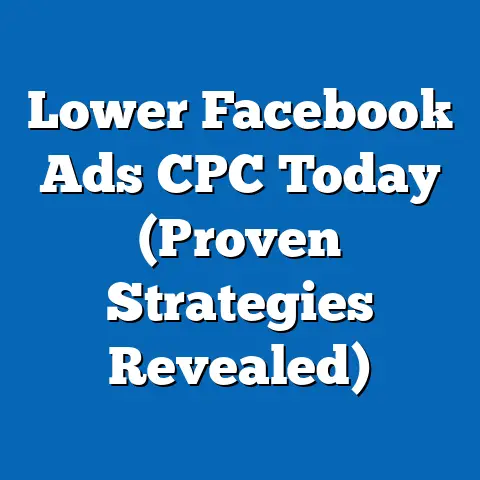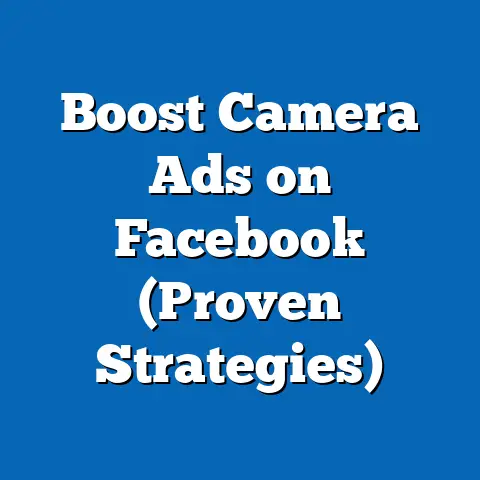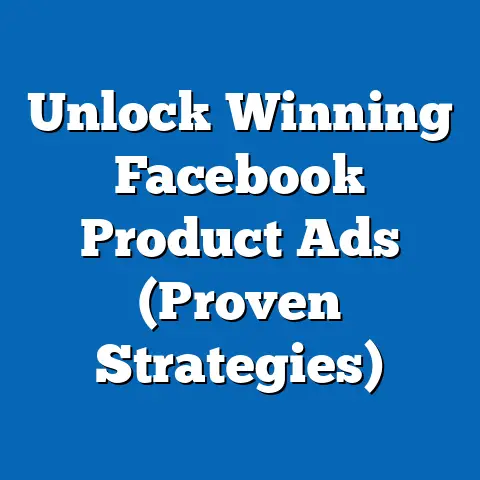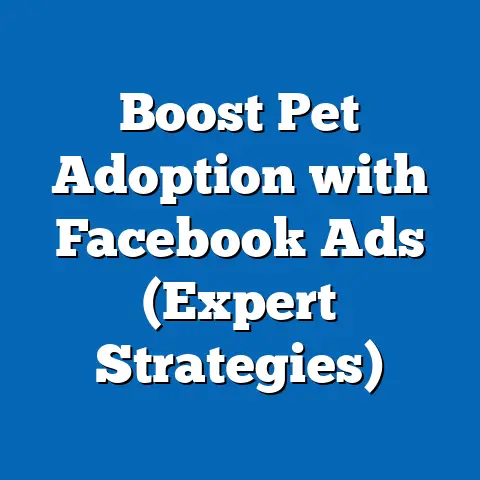Streamline Facebook Ads Exports (Efficiency Unlocked)
Streamline Facebook Ads Exports: Efficiency Unlocked
Imagine running a thriving pet supply store. You’ve got adorable dog toys, comfy cat beds, and nutritious food options galore. Now, you want to reach more pet parents online, so you turn to Facebook Ads. But managing those ads, tracking performance, and trying to make sense of all the data can quickly become overwhelming. That’s where streamlining your Facebook Ads exports comes in. It’s like having a super-organized assistant who keeps all your ad data in perfect order, saving you time, reducing errors, and ultimately helping you grow your pet business.
The pet industry is booming online. According to recent statistics, online pet product sales are projected to reach unprecedented levels in the coming years. But with this growth comes increased competition. To succeed, pet businesses need to be smart about their advertising, and that starts with efficient data management. I’ve seen businesses struggle with messy data, spending hours manually compiling reports. It’s a huge drain on resources and can lead to missed opportunities. This guide is all about helping you avoid those pitfalls and unlock the power of streamlined ad exports.
Understanding Facebook Ads for Pet Businesses
Overview of Facebook Ads
Facebook Ads are essentially paid messages that you display on the Facebook platform. For pet businesses, this is a goldmine! Think about it: millions of pet owners are scrolling through Facebook every day, sharing photos of their furry friends, joining pet-related groups, and searching for pet products. Facebook Ads allow you to target these individuals with laser precision.
There’s a wide variety of ad formats you can use:
- Carousel Ads: Perfect for showcasing multiple pet products in a single ad. Imagine displaying a range of dog toys, each with its own image, description, and link to purchase.
- Video Ads: Ideal for telling a story or demonstrating how your product works. A video of happy cats playing with your catnip toy? Irresistible!
- Collection Ads: Great for creating a visually appealing shopping experience. Users can browse a catalog of your pet products directly within the ad.
- Image Ads: Simple but effective. A high-quality image of a cute pet using your product can be incredibly persuasive.
I remember working with a local pet grooming salon that was struggling to attract new clients. We ran a Facebook Ad campaign featuring before-and-after photos of groomed pets, and the results were amazing. Their appointment bookings skyrocketed within weeks. The key was using visually compelling content and targeting the right audience.
Target Audience Identification
This is where the magic happens. Facebook allows you to target your ads based on a wide range of factors, including:
- Interests: Target people who have expressed interest in specific pet breeds, pet care tips, or pet products.
- Demographics: Target based on age, location, income, and education.
- Behaviors: Target people who have purchased pet products online, visited pet stores, or attended pet-related events.
- Custom Audiences: Upload your existing customer list to target people who have already interacted with your business.
- Lookalike Audiences: Find new customers who are similar to your existing customers.
Let’s say you’re selling organic dog food. You could target dog owners who are interested in holistic pet care, live in affluent neighborhoods, and have purchased organic products online in the past. The more specific you get, the more likely you are to reach the right people and drive conversions.
Key Objectives of Pet Advertisers
Before you start running Facebook Ads, it’s crucial to define your objectives. What do you want to achieve? Common goals for pet businesses include:
- Brand Awareness: Increase awareness of your brand among pet owners.
- Lead Generation: Collect email addresses or contact information from potential customers.
- Sales Conversions: Drive sales of your pet products or services.
- Website Traffic: Drive traffic to your website or online store.
- Engagement: Increase engagement with your Facebook page, such as likes, comments, and shares.
I once helped a small pet boutique launch a new line of handmade dog collars. Their primary objective was to drive sales conversions. We created a Facebook Ad campaign featuring high-quality images of the collars, targeted dog owners who had purchased similar products online, and included a clear call to action to “Shop Now.” The campaign was a huge success, generating a significant increase in sales.
Takeaway: Understanding the basics of Facebook Ads, identifying your target audience, and defining your objectives are the foundation for successful advertising in the pet industry.
The Importance of Data Management in Facebook Ads
Data Collection and Analysis
Data is the lifeblood of any successful Facebook Ad campaign. By tracking and analyzing your ad performance, you can identify what’s working, what’s not, and make informed decisions to optimize your campaigns. Key metrics to focus on include:
- Impressions: The number of times your ad was shown.
- Reach: The number of unique people who saw your ad.
- Click-Through Rate (CTR): The percentage of people who clicked on your ad after seeing it.
- Cost Per Click (CPC): The average cost you paid for each click on your ad.
- Conversion Rate: The percentage of people who took a desired action (e.g., made a purchase) after clicking on your ad.
- Return on Ad Spend (ROAS): The amount of revenue you generated for every dollar you spent on advertising.
I’ve seen businesses completely transform their ad performance by simply paying attention to their data. For example, I worked with a pet food company that was struggling to generate sales. By analyzing their ad performance data, we discovered that their ads were performing well among cat owners but not dog owners. We adjusted their targeting and messaging accordingly, and their sales skyrocketed.
Common Data Management Challenges
While data is essential, managing it effectively can be challenging. Some common issues include:
- Data Overload: With so many metrics to track, it’s easy to get overwhelmed.
- Integration Issues: Integrating Facebook Ads data with other marketing platforms (e.g., CRM, email marketing) can be complex.
- Interpretation Difficulties: Understanding what the data means and how to use it to improve your campaigns can be difficult.
- Manual Reporting: Compiling reports manually can be time-consuming and prone to errors.
I remember one client who was spending hours each week manually compiling Facebook Ads reports. It was a huge drain on their time and resources. We implemented an automated reporting solution that saved them hours each week and provided them with real-time insights into their ad performance.
Takeaway: Effective data management is crucial for optimizing your Facebook Ad campaigns and achieving your business goals.
Streamlining Facebook Ads Exports
What is Ad Exporting?
Facebook Ads exporting is the process of extracting data from your Facebook Ads Manager account and saving it in a format that can be used for analysis, reporting, or integration with other systems. This data can include information about your campaigns, ad sets, ads, and performance metrics.
Think of it as taking all the information about your pet business’s Facebook Ads and putting it into a neat, organized spreadsheet. This allows you to analyze the data, create reports, and share it with your team.
Benefits of Streamlined Exports
Streamlining your ad exports offers numerous benefits:
- Time Savings: Automate the process of extracting and formatting data, freeing up your time for other tasks.
- Improved Accuracy: Reduce the risk of manual errors and ensure that your data is accurate and reliable.
- Enhanced Collaboration: Share data with your team in a clear and organized format, facilitating collaboration and decision-making.
- Better Insights: Analyze your data more effectively and identify trends and patterns that can help you improve your campaigns.
I’ve seen businesses significantly improve their ad performance by streamlining their ad exports. By automating the reporting process, they were able to identify underperforming ads and make adjustments quickly, resulting in a significant increase in their ROAS.
Tools and Software Solutions
Several tools and software solutions can help you streamline your Facebook Ads exports:
- Facebook Ads Manager: Facebook’s native tool for managing your ads. It allows you to export data in various formats, including CSV and Excel.
- Third-Party Analytics Tools: Tools like Supermetrics, Funnel.io, and Adverity offer advanced reporting and data integration capabilities.
- Google Data Studio: A free tool that allows you to create interactive dashboards and reports from your Facebook Ads data.
- Excel: A powerful spreadsheet program that can be used to analyze and visualize your Facebook Ads data.
I’ve personally used Supermetrics with great success. It allows me to automatically pull data from Facebook Ads into Google Sheets or Google Data Studio, creating real-time dashboards that provide valuable insights into ad performance.
Takeaway: Streamlining your Facebook Ads exports can save you time, improve accuracy, and enhance collaboration, ultimately leading to better ad performance.
Best Practices for Efficient Ad Exporting
Organizing Campaigns and Ad Sets
The way you organize your campaigns and ad sets can significantly impact the ease of exporting and analyzing your data. Here are some tips:
- Use Clear Naming Conventions: Use consistent and descriptive naming conventions for your campaigns, ad sets, and ads. For example, “Dog Food – Organic – Targeting Dog Owners.”
- Categorize Your Campaigns: Group your campaigns into categories based on product type, target audience, or objective.
- Use Tags: Use tags to further categorize your campaigns and ad sets.
I always recommend creating a spreadsheet to document your naming conventions and categorization strategies. This ensures consistency across your team and makes it easier to filter and analyze your data.
Automating Reporting Processes
Automation is key to saving time and improving accuracy in ad reporting. Here are some ways to automate your reporting processes:
- Use Facebook’s Automated Reporting Features: Facebook Ads Manager offers automated reporting features that allow you to schedule reports to be sent to your email address.
- Use Third-Party Reporting Solutions: Tools like Supermetrics and Funnel.io offer advanced automation capabilities, allowing you to automatically pull data from Facebook Ads into your reporting platform of choice.
- Use APIs: If you’re comfortable with coding, you can use the Facebook Ads API to automate the process of extracting and formatting data.
I’ve found that setting up automated reports to be sent to my inbox every week is a great way to stay on top of my ad performance. It allows me to quickly identify any issues and make adjustments as needed.
Regular Audits and Maintenance
It’s important to regularly audit and maintain your ad exports to ensure that the data is accurate and relevant. Here are some tips:
- Check for Errors: Regularly check your ad exports for errors and inconsistencies.
- Update Your Naming Conventions: As your business evolves, your naming conventions may need to be updated.
- Remove Obsolete Campaigns: Remove any obsolete campaigns or ad sets from your account to keep your data clean.
- Review Your Automation Settings: Regularly review your automation settings to ensure that your reports are being generated correctly.
I recommend setting aside time each month to review your ad exports and make any necessary adjustments. This will help you stay organized and ensure that you’re making informed decisions based on accurate data.
Takeaway: By organizing your campaigns, automating your reporting processes, and conducting regular audits, you can streamline your Facebook Ads exports and unlock valuable insights into your ad performance.
Conclusion
Streamlining your Facebook Ads exports is essential for pet businesses looking to maximize their advertising ROI. By understanding the basics of Facebook Ads, managing your data effectively, and implementing best practices for efficient ad exporting, you can save time, improve accuracy, and make better decisions.
I’ve seen firsthand the transformative power of streamlined ad exports. It allows businesses to focus on what they do best – providing amazing products and services to pet owners – rather than getting bogged down in data management.
So, take a look at your current ad exporting practices. Are you spending too much time manually compiling reports? Are you struggling to make sense of your data? If so, it’s time to implement the strategies discussed in this guide. Your pet business – and your sanity – will thank you for it!
Now go forth and conquer the world of Facebook Ads! Your furry friends are counting on you.






